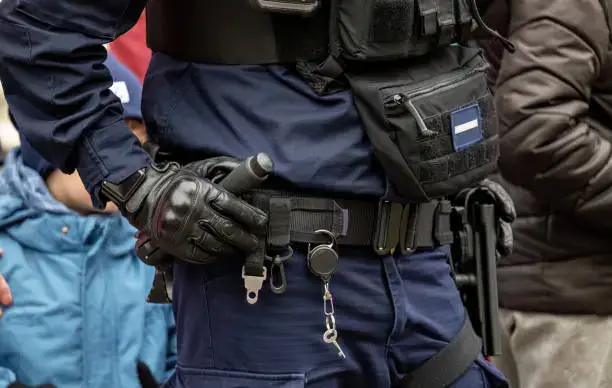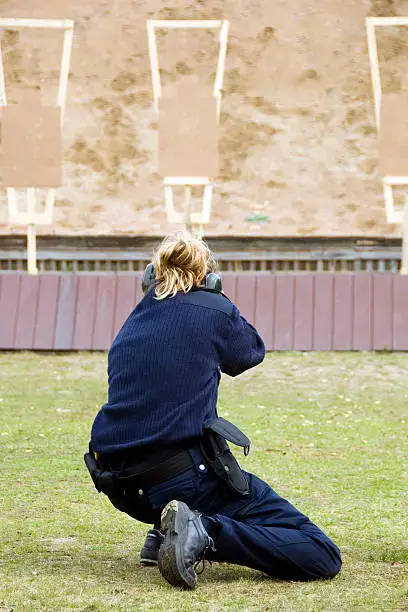タクティカルベルトは、ホルスター、マガジンポーチ、メディカルキット、ツールなど、必要不可欠なギアを安全に持ち運ぶために設計された重要な耐荷重装備品です。タクティカルベルトを正しく装着することで、法執行、軍事作戦、野外活動など、過酷な任務の際にも快適性、安定性、装備への素早いアクセスが確保されます。不適切な装着は、不快感や動きの制限、ギアの故障につながります。
2009年以来15年以上にわたってタクティカルギアを製造してきた経験から、プロフェッショナルが効果的にデューティーベルトシステムをセットアップできるよう、このガイドを紹介する。
正しいタクティカル・ベルトの選択
高品質のタクティカルベルトは、装着したギアの重量をたるみやねじれなしに支える剛性を備えていなければならない。耐荷重作業用に特別に設計された、ポリマーインサートやヘビーデューティー素材で補強されたデューティーベルトを探すこと。カジュアルな使用を目的としたフレキシブルなベルトは、必要なサポートがないため避けること。
最近のタクティカルベルトは、ズボンのループに通す柔らかいインナーベルトと、ギアを固定する硬いアウターベルトの2部構成になっているものが多い。これらは面ファスナー(一般にベルクロ®として知られる)でしっかりと接続される。インナーベルトとアウターベルトの幅(一般的には1.75″または2″)が適合し、面ファスナーの面が揃っていることを確認し、強力に結合してください。
内側のベルトは、ズボンのループに快適にフィットするよう、標準的なベルトと同じサイズにする。アウターベルトは、装備に応じて2~4インチ長めにしてください。サイズが合っていないと安定性が損なわれることがあるため、必ずメーカーのサイズ表を参考にしてください。
インナーベルトのセットアップ
通常のベルトと同じように、ズボンのループにインナーベルトを通します。締めすぎず、ぴったりと快適にフィットするようにバックルで調整します。インナーベルトが安定した土台となり、アウターベルトがギアの重量を担います。
アウターベルトへのギアの取り付け
アウターベルトを着用する前に、アクセシビリティとバランスを最適化するためにロードアウトを計画する。
ホルスター、マガジンポーチ、メディカルキット(IFAK)、ツールなど、ギアを並べ、配置を考える。使用頻度の高いものを優先的に入れ、ベルトがずれないように重さを均等にする。
- MOLLE/PALSウェビング:MOLLE(Modular Lightweight Load-carrying Equipment)またはPALS(Pouch Attachment Ladder System)ウェビングを使用し、ポーチをしっかりと編み込む。すべてのストラップがしっかりとロックされていることを確認してください。
- ベルトループ:内蔵ループ付きギアをアウターベルトに直接スライドさせる。
- クリップまたは金具:Tek-Lok、G-フック、マリースクリップなどのアタッチメントを、メーカーの指示に従い確実に取り付けてください。
- 場所 利き手側の腰にプライマリー・ホルスターを装着し、素早くアクセスできるようにする。
- ポジション 腰骨の前にマガジンポーチがあり、リロードが容易。
- 場所 メディカルキットやダンプポーチのような緊急性の低いものは、後方またはサポート側に置く。
- バランス ベルトの傾きやたるみの原因となる荷重の不均等を避けるため。

アウターベルトの固定
インナーベルトを所定の位置にセットし、その上にアウターベルト(ギアを装着したもの)を合わせます。面ファスナーをしっかりと押して完全にはめ込み、安定した接続を確保する。アウターベルトのバックル(強度を高めるためにコブラバックル、または調整機能を高めるためにラダーロックが一般的)を、インナーベルトのバックルと重ならないように中心から少しずらして留める。
ベルトがしっかり固定され、かつ指2本が楽に入るようにテンションを調整してください。締めすぎると動きが制限され、疲労の原因になります。
ベルトを身体に装着する
タクティカルベルトは腰ではなく、臀部(腸骨稜)に装着する。腰は装備の重量を支える安定した足場となる。ベルトの位置が高すぎると腹部が圧迫され、低すぎると安定性が低下し、脚の動きが制限される。曲げたり、ひねったり、ステップを踏んだりといった可動域をテストし、ベルトが挟まったりずれたりすることなく固定されていることを確認してください。
重量配分と安定性のチェック
セットアップ後、ベルトのバランスを評価する。どの側も著しく重く感じないことを確認し、すべてのギアがしっかりと取り付けられていることをチェックする。マガジンやツールなどの主要アイテムにアクセスする練習をし、引っかかることなく簡単に手が届くことを確認する。必要であれば配置を調整し、スムーズにアクセスできるようにする。

使用中の安定性の維持
よくフィットしたタクティカルベルトシステムは、走ったり、膝をついたり、しゃがんだりするようなダイナミックな動きでも安定していなければならない。ベルトがずれると
- フックとループの接続が完全に機能していることを確認します。
- アウターベルトの張りを調整し、緩みをなくす。
- 重いものを再配分してバランスをとる。
- システムをサポートするために、パンツとインナーベルトが正しくフィットしていることを確認する。
タクティカルベルトのお手入れ
- クリーン・フック・アンド・ループ:グリップ力を維持するため、硬めのブラシで面ファスナー表面の汚れやゴミを取り除く。
- 定期的な検査:縫い目、バックル、取り付け部分に磨耗がないか点検してください。損傷した部品は速やかに交換してください。
- 適切に保管する:形状や剛性を保つため、ベルトは平らな状態か、ゆるく巻いた状態で保管する。
結論
適切に装着されたタクティカルベルトは、快適性、安定性、ギアへの素早いアクセスを提供し、効果的なロードアウトの基礎となります。剛性の高いベルトを選び、正しいサイズに設定し、ギアを戦略的に取り付け、腰に装着することで、プロフェッショナルな活動やアウトドア活動で最適なパフォーマンスを発揮することができます。
当社は、15年以上にわたって戦術的な耐荷重装置の製造に携わってきた専門知識を生かし、耐久性が高く、カスタマイズ可能な設計を行っています。 ベルト タクティカルギアカタログをご覧ください。タクティカルギアカタログをご覧いただき、お客様のミッションに合わせたソリューションをお探しください。
注:具体的なテクニックは個々の体型や任務の要件によって多少異なるが、腰の位置、確実な装着、バランスの取れた重量、締め過ぎの回避といった基本原則は変わらない。プレートキャリアとベルトを一体化させるなど、高度なテクニックについては、以下のリソースを参照。 全米戦術士官協会 またはプロのトレーナーに相談する。
関連記事: タクティカルベルトプロフェッショナルのための品質とカスタマイズ